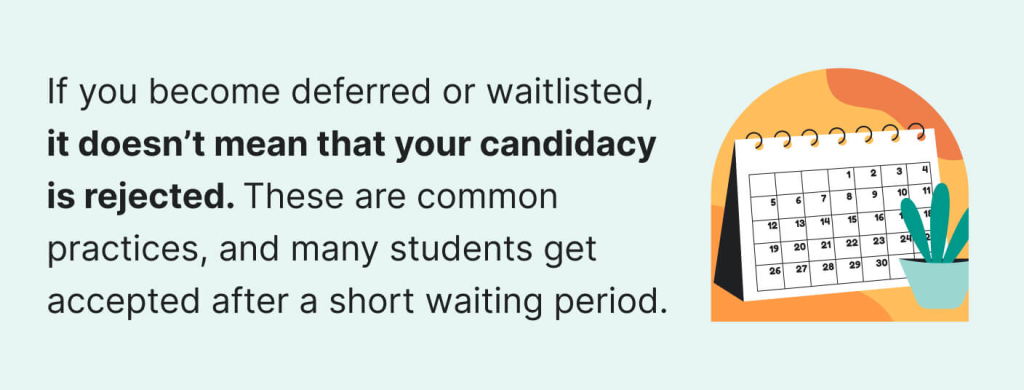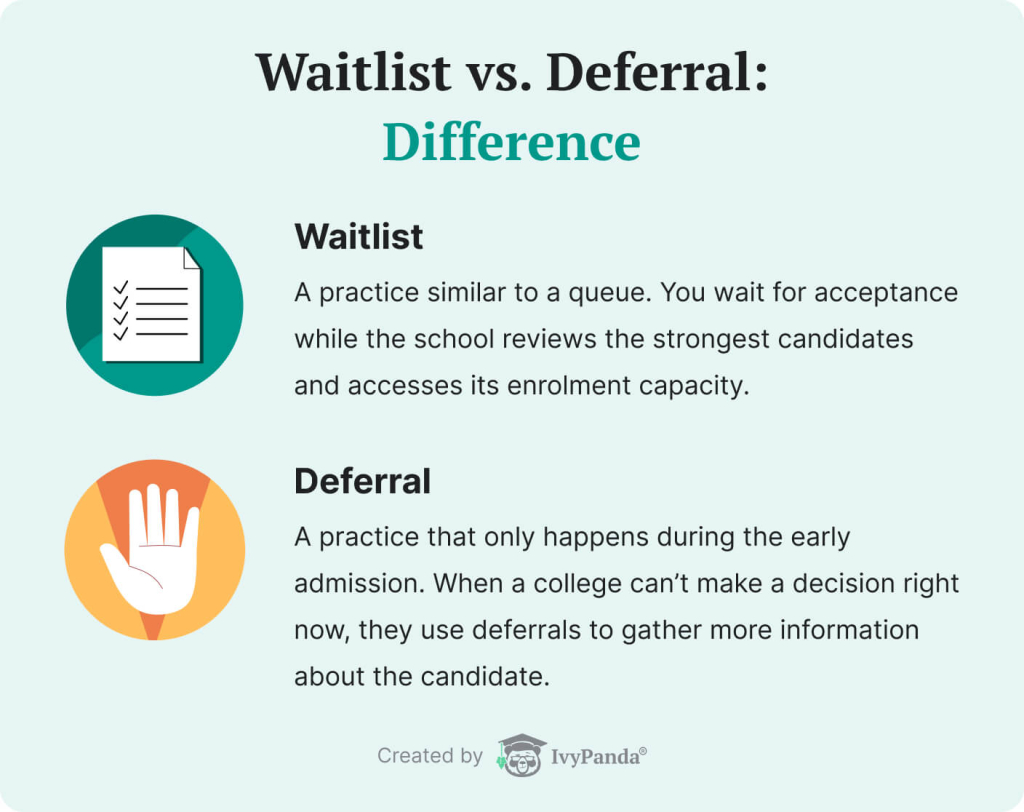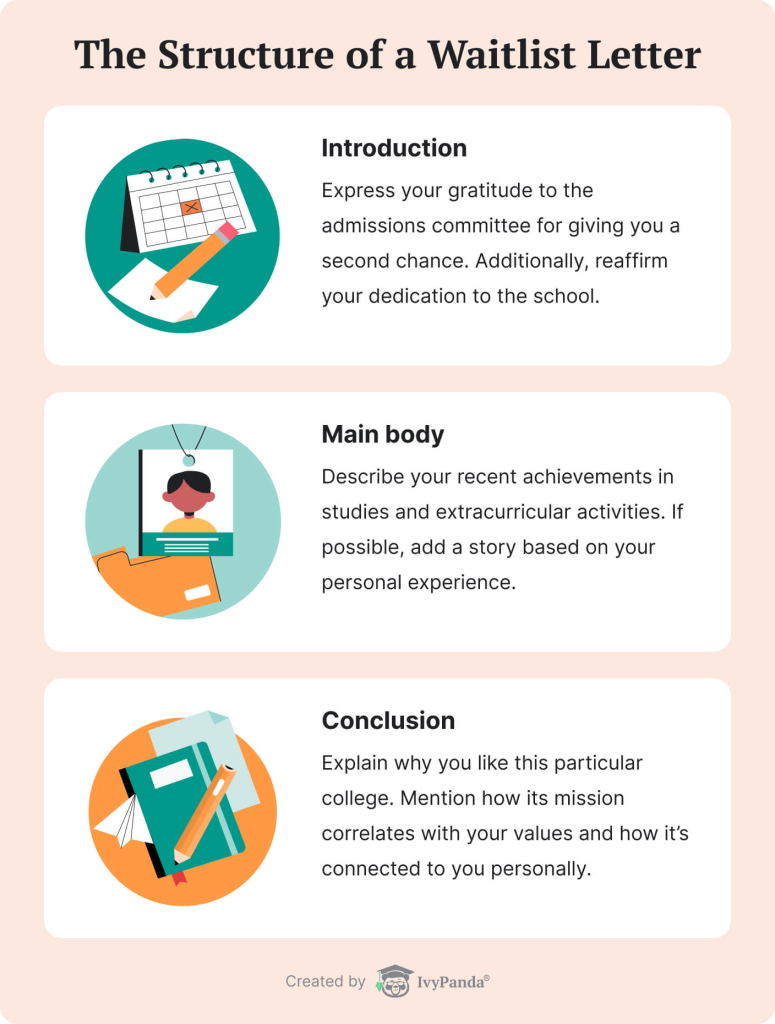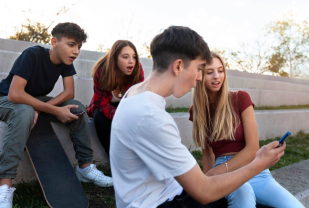Waiting for college admission can be very tedious and nerve-racking. It feels even worse upon getting a “deferred” or “waitlisted” status.
“What does this mean? Did the committee not like me? What should I do next?” These questions immediately start raging in the student’s head, making it go boom.

If you wish to avoid unnecessary stress, check out this article! Here, our experts will clarify what you should and shouldn’t do if you receive a “deferred” or “waitlisted” status. You will also learn how to write a letter of continued interest and the truth behind the most widespread myths regarding waitlists and deferrals.
Sounds interesting? Let’s start!
👨🎓 The Difference Between Waitlists and Deferrals
Many students assume waitlists and deferrals are the same things, and some don’t know what these terms mean. In the next segment, we’ll cover their definitions and differences so you don’t get confused.
What Does “Waitlisted” Mean?
A waitlist is not a rejection or acceptance: it’s a situation where you wait for your turn until the university accepts the strongest students and completes all its preparations.
Waitlists are basically queues. Universities use them to take a timeout and clear their enrollment capacity for new students. Interestingly, private colleges use waitlists more often than public ones.
Schools can resort to creating waitlists for many reasons, like:
- There is not enough enrollment capacity to accept all candidates.
- There are some debatable aspects in your documents that the university is reviewing.
- The committee like you as a candidate but can’t take you just now because there are stronger students in line.
- The university doesn’t meet its enrollment plan and resorts to waitlists as a source of available applicants.
- A waitlist serves as a priority list to separate admissible students from the rest of the candidates.
The chances of getting rejected or enrolled are 50/50, and there are no guarantees. If the university’s enrollment capacity is big enough to admit every strong student before and after you, they will accept you.
College Deferrals Explained
Deferrals are not the same as waitlists. They are a rejection for early admission—hence, only colleges that provide early admission use them.
Here are the primary reasons for deferring students:
- When a college can’t make a decision right away, they use deferrals to gather more details about the candidate.
- Deferrals are also used when there are a lot of strong students which prevents the commission from reviewing your candidacy with them.
- Getting deferred may mean that the admissions committee liked you as a candidate but decided to give you some time to work on your skills so you become a more competitive applicant.
- If you consider the university as a backup, the admissions committee may sense that and send you a deferral to motivate you.
So, if you become deferred, it doesn’t automatically mean something is wrong with your application. The university is likely just waiting for a better moment.

🤔 Deferred vs. Waitlisted: Which Is Better?
While being deferred or waitlisted leaves open the chance of eventually being accepted, there are distinctions between the two situations, and each comes with its own pros and cons. Let’s cover all of them so you know what to prepare for.
Pros and Cons of Deferrals
✅ Pros:
- It gives you a second chance to improve your application and become a stronger candidate.
- The university doesn’t reject you and will keep monitoring your progress.
- If you’re deferred, it means you’re separated from the rest of the regular candidates.
❌ Cons
- You can still get rejected if you don’t become more competitive.
- Being deferred likely means that your application lacks something.
- Being deferred puts you in a gray area between admission and rejection.
Pros and Cons of Waitlists
✅ Pros:
- Being waitlisted means that the university is still interested in your candidacy.
- It improves your chances of being accepted if there are places left.
- While waiting in the queue, you can take time to improve your skills.
❌ Cons:
- If the enrollment limit is exceeded, you’ll be rejected.
- You’ll never know when a free enrollment spot opens up.
- The chances of receiving an admission are lower than when you receive a college deferral.
At the end of the day, only you can decide which is better—being waitlisted or deferred. Each has its benefits, and they’re both not as scary as they seem.
📊 Waitlist Statistics, Facts, and Trends
Usually, around 20% of waitlisted students are offered admissions. But it’s not always the case: the situation varies from one school to another, and the numbers tend to change every year.
To better understand your chances, let’s take a look at how often students got admitted to various universities in 2025:
- Virginia Tech offered admission to 32% of students off the waitlist.
- Cornell University admitted 5% of students from the waitlist.
- UCLA accepted only 3% of waitlisted students.
- Purdue University didn’t admit anyone.
We can also compare broader statistics from 2022 to the previous years:
- 62% of schools admitted 10% or less of the students on the waitlist. In 2021, the number was higher (57%).
- Just like a year before, a total of 19% of waitlisted students were admitted.
Overall, the chances are pretty high, especially in less selective colleges. Many students get accepted after a short waiting period. So, don’t let waitlists and deferrals discourage you—there is nothing to fear!
🔥 Top 16 Strategies for Deferred or Waitlisted Students
It may not be obvious, but a “waitlisted” or “deferred” status presents a unique opportunity to demonstrate your motivation and resilience. So, why not seize it? Keep reading to learn about the most actionable strategies that will help you maximize your chances of ultimately securing your spot at the school of your dreams.
1. Determine Your Next Steps
If your name has been placed on a waitlist, we recommend you immediately work out what you are planning to do next. The best option at this stage would be to understand the reasons behind your waitlisted status and think about the best course of action. In particular, decide whether to continue pursuing a place at this specific school or consider an alternative.
2. Accept or Decline the Waitlist Invitation
After you’ve cleared your head and reviewed your potential options, you can decide on the waitlist spot. If this university is your best pick and you have a real chance of getting off the waitlist, then accept the invitation. If you don’t think so, then decline it and reevaluate your backup options.
💡 Quick tip:
Try to complete this step as soon as possible! The university won’t wait for your decision forever.
3. Choose a Backup College
We recommend you have a Plan B before rejecting a waitlist spot. Review your list of top universities once again and understand the admission requirements for each one. Ensure you’ll be able to enroll elsewhere without getting waitlisted again.
If you are waitlisted or deferred at the college of your dreams, try finding a similar one from your backup list. The waitlist decisions are often not made public until after May 1, so you’ll have time to consider your options.
4. Check Your Application Status
Keeping in contact with the college where you were waitlisted or deferred is crucial. This way, you’ll avoid unpleasant surprises. There is usually a special section on the universities’ websites where you can find your application and check its status. If you can’t find it, then contact the staff directly.
💡 Quick tip
We recommend checking on the status of your application as often as you can during admissions season. But don’t overdo it! If you call the committee daily, they may eventually get tired of you, which will lower your chances of getting admitted.
5. Be Realistic
Staying rational will help you objectively evaluate your chances. The following factors can assist you in doing it. Note that:
- The more free spots on the enrollment list, the higher your chances.
- The admissions committee will favor you if your field of study aligns with the university’s requirements.
- If you’re motivated and actively demonstrate it, the committee will put you above less motivated candidates.
- The stronger your application is, the higher you will be on the waitlist.
- The lower the percentage of admitted students last year, the higher it will be this year.

6. Follow the School’s Instructions
As a rule, colleges publicly announce their instructions for anyone who got deferred or waitlisted. Find these instructions and use them to answer the following questions:
- Which documents do you need to prepare?
- What is not required of you?
- What accomplishments and credentials do you need to have?
- In what ways can you strengthen your candidacy?
- How long will your college deferral or waitlist last?
If the university provides no instructions, feel free to ask officials for help. You can address your questions to the admissions committee or university secretary. The phone numbers and email addresses are usually found on the university’s website.
7. Send Important Updates
While you’re waiting for your waitlist or deferral to end, be proactive! Try to improve your skills and earn some extra credentials. While you’re at it, keep informing the admissions committee about your progress. They need to see that you take their requirements and expectations very seriously.
8. Focus on Supplemental Materials
After you’ve checked the school’s instructions for deferred and waitlisted students, we recommend you pay extra attention to supplemental material. It will improve your chances and make your application more competitive.
There are many things you can do in this regard:
- Try retaking the SAT to get a better result. It’s a great and relatively easy way to strengthen your candidacy.
- Start attending extra courses and maybe hire a private tutor. It will help you deepen your knowledge of specific subjects. You can also mention it in your waitlist letter, which we will cover later in this article.
- Be more active in your extracurricular activities. The more achievements and certificates you have, the more the admissions committee will want you. Also, it’s a great way to boost essential skills and abilities!
9. Stay in Contact with the School
Another good strategy is to remain in contact with the admissions committee. It can give you an upper hand and help university officials make their final decision. Also, we recommend you show them that you’re motivated and genuinely want to study at their university. When the time comes and the waitlist or deferral ends, you’ll be ready to demonstrate how much you’ve improved and thus become a much stronger candidate.
10. Submit Your Deposit to Your Next-Choice College
As you know, being waitlisted means you have fewer chances of admission than in the case of deferrals. If you’ve been waitlisted, we recommend you to choose a good backup university, accept their offer, and make a deposit (it’s usually around a few hundred dollars). You can inform the backup of your plan change at any time if you get off the waitlist. Sadly, you won’t be able to get your deposit money back, but it’s nothing compared to having nowhere to study.
11. Let the College Know You Can Pay
Reminding schools that you are able to pay for your studies never hurts, especially during the first year. Admissions committee members know that allowing a full-paying student in can relieve their budget. If you tell them that you have all the required funds and that your family won’t have problems paying for your education, they will be more attentive to your candidacy.
12. Identify Weaknesses in Your Application
This is one of the most effective strategies. If you really want admission, it’s vital to keep your application strong and competitive. Don’t hesitate to ask your school counselor about your initial weaknesses and ways to improve them.

To help you with this important task, we present to you the ways to fix the drawbacks commonly found in applications.
- An outdated application. Add all the recent updates regarding your skill growth and achievements. Don’t forget to mention how much you’ve improved since your initial application.
- Making a brand of yourself. Don’t oversaturate your statement with emotions. The committee doesn’t want to hear students bragging about themselves or begging for a second chance. It’s crucial to have self-respect and be professional.
- Being too cursory. It’s best to talk more about your personal experience without exaggeration yet with passion.
- Forgetting to thank the university. Remember to thank the university and the commission for their time and attention. Be polite and respectful.
13. Get a Recommendation Letter
This is another excellent strategy for improving your chances of getting admitted. If you know any teachers, business people, or other people of influence, ask them to write you a recommendation letter. It’s even better when you know somebody from the university you’re applying to. Just remember that this letter must highlight your positive aspects only. If it is critical of you, you are better off without it.
14. Visit Campus
A good way of showing your passion and motivation is to visit campus. It will allow you to get to know the college from the inside and make new acquaintances who can vouch for you. Try making friends with professors and other students—they can be of great help later. Some professors may even invite you for an interview, which can become your actual golden ticket!
💡 Quick tip:
Visiting campus is also a great way to learn about the skeletons in the university’s closet. If you think the school is the place of your dreams, this impression may change once you visit it. This way, your expectations will be more realistic.
15. Stay Patient
Staying calm and composed is crucial for conserving your energy and nerves for more essential things. If you’ve done all you could but still ended up on the waitlist, don’t panic! You must understand that there is nothing wrong with your candidacy. It’s just that there are many things universities weigh up when making their decisions. Some can’t be changed no matter how hard we try, while others we can influence. Do everything in your power to get admitted, and everything will be alright.
Regardless of how hopeless the situation may look, there are always chances of success. Remember that you’ll get off the waitlist eventually. All you have to do is keep trying!
16. Write a Waitlist Letter
This is the most significant thing we recommend. If you want to seriously increase your chances, write a waitlist letter. It’s a fantastic strategy that effectively shows your interest and devotion to the admissions committee. If you want to learn how to create the ideal waitlist letter, read on!
✍️ Letter of Continued Interest: What It Is & How to Write It
The waitlist letter (a.k.a. the letter of continued interest) is a piece of writing that aims to prove that you will be an excellent addition to their first-year class. It outlines the accomplishments you have made since submitting your initial application and reaffirms your desire to study.

Your letter of interest can be uploaded to the university’s internet portal, emailed, or written in your college’s waitlist response form. Check out the school’s application page directly for more specific instructions on submitting the letters. Don’t forget that they are typically due mid-February (after the committee’s initial examination of submissions is complete).
The Goals of a Waitlist Letter
A waitlist letter aims to:
- Show that you are still interested in the college. Many students quit trying when they end up on the waitlist. That’s why it’s vital to tell the admissions committee that your candidacy is still active and that you haven’t given up on your dream.
- Address the weaknesses of your original application. Writing a letter of continued interest is your way to fix your past application mistakes and prove that you can do better.
- Demonstrate all the progress you’ve made since your first application. One of its main goals is to convince the committee that the candidate they’re reviewing will continue enhancing their skills and personal qualities.
What to Include in Your Letter
A truly exceptional waitlist letter should comprise all of the following components:
- Your ongoing enthusiasm and desire to receive approval. Explain why receiving admission is so critical for you.
- Achievements that you have made since submitting the initial application. Highlighting a couple of them will suffice. Remember that only the most significant achievements are worth mentioning.
- Any supporting images or videos of your recent successes. You can include links to important blog posts, a LinkedIn profile, or any other professional social media platform.
Structure of a Waitlist Letter
The structure of a waitlist letter typically includes the following:
- An introduction.
Here, thank the admissions committee for taking another look at your application and giving you a second chance. Reaffirm your dedication to the school. - Main body.
In this part, you enumerate your recent achievements that weren’t listed in the initial application:- If you’ve made progress in a subject you had struggled with before, describe it in your letter.
- It’s also essential to let the committee know you have increased your dedication to meaningful extracurricular activities such as activism or volunteering.
- Including a personal story would make your application shine.
- Finally, address the weaknesses of your initial application and clarify how you have fixed them.
- Conclusion.
At the end of your letter, you can thank the commission for their attention and reiterate why this particular college appeals to you. Describe why you care about it and how your values correlate with those of the school. Including a personal anecdote linking you with the institution can further improve your case.

Tips for a Winning Letter of Interest
So, now you know what to cover in your waitlist letter and how to structure it. But how can you make it perfect? And what is best to avoid? Well, here are our key advice that will help you maximize your success:
- Keep it short. A proper letter of interest doesn’t exceed 2 pages. To stay within the word limit, try to avoid redundancy and add only the most significant facts. Besides, make sure not to say the same thing twice.
- Keep it up-to-date. The admission committee has to know everything you’ve learned since your initial application, including your newly gained skills, knowledge, certificates, achievements, etc.
- Prove your fit. If you’re confident that you will enroll if accepted, write that. You want everyone to realize that you belong at this school and that you’ll do all you can to contribute to its mission and values.
- Sound motivated. You’re expected to underline your interest in the university, so be sure to sound enthusiastic! This way, you’ll emphasize how essential it is for you to receive admission.
- Be yourself. Despite the formal tone of the waitlist letter, you should sound natural. For instance, try substituting the word “undoubtedly” with something less formal and more emotional, like “in a heartbeat.”
- Keep it positive. Telling the commission how hard it was for you to pass all these exams and how sad you feel for ending up on the waitlist is not the brightest idea. Try adding a little fun to your letter. That way, the commission will feel your optimism, making them more positive toward you.
Example of a Great Waitlist Letter
Now that you know the basics of writing a waitlist letter, it’s time to see what it can actually look like. Below is an example of a perfect waitlist letter: read it and get inspired!
Dear Mr. Smith,
I am writing to inform you that my Orange University application has been placed on a waiting list. Going to Orange University has been a dream of mine for the longest time. If I were to be taken off the waitlist, I would gladly enroll and walk through the doors of your university as soon as possible. I would like to use this opportunity to inform you of updates regarding my recent accomplishments. I sincerely hope that by doing so, I will prove to you that I am a worthy candidate.
For the past few weeks, I have been studying physics for over 4 hours daily at the Lambda laboratory. This experience has helped me successfully conduct research based on my studies. My research was presented at the high school science fair, and I won the first prize. My LinkedIn page at [URL] has a video and images from my science fair presentation.
In addition, I’ve completed an entire AP course to push my math skills even further. I’ve also deepened my knowledge of science-oriented subjects offered at my high school. This improvement resulted in me passing each class with an A.
I sincerely hope to continue strengthening my skills and participating in science fairs at Orange University. I truly appreciate your ongoing attention to my application.
Sincerely,
John Johnson.
🧩 What to Do & Not Do While Waiting
While you wait for admission, it’s important not to go overboard. Some things that may seem like a good idea will actually lower your chances of getting admitted! That’s why you should definitely check out the following dos and don’ts.

Things You Can Do
- Start preparing for your future at the university. Do some digging and learn as much as you can about academic life.
- Consider getting a transfer from another university to the school of your dreams in case your chances of getting off the waitlist are low.
- Evaluate your finances by creating a list of potential expenses.
- Gather with your parents and discuss your future plans.
- Take another look at your backup universities. Maybe some of them are even better than the one you’re waitlisted at!
Things to Avoid
- Don’t bombard the admissions committee with your letters, documents, and calls. Try to get all the information together and submit it all at once.
- Don’t resort to desperate measures. Even if your chances are low, don’t bribe or beg. You’ll make it even worse. The commission won’t tolerate bribes; even sweets will only make them angry.
- Don’t give up. Always remember that you will get what you want if you try hard enough.
🎁 BONUS: Waiting List Myths Busted
Many myths surrounding college deferrals and waitlists can cause confusion and make some students panic. We don’t want that to happen to you! That’s why as a bonus for our readers, we will cover some of the most popular myths and see if they’re true or not.
- The committee only uses facts from the initial application.
Students are free to inform the college about their newly acquired skills and achievements. The committee will review all of that before the final admission. - There is a way to move up the waitlist.
Typically, it’s impossible to move up the waitlist, but sometimes schools rank their lists to allow such a possibility. Overall, it varies from college to college. - A student can get off the waitlist by sending a referral from the school’s principal or teacher.
A recommendation letter can help if the commission is struggling with its final decision. In other cases, it won’t do much for you, as university commissions rarely take advice from third parties. - Someone who is placed on a waitlist is not a good fit for the school.
Usually, this is not the case. Waitlists are not blacklists. If there are too many candidates, colleges use waitlists to separate the strongest ones from the rest. - Being placed on a waitlist equates to being rejected.
This is a blatant lie. In fact, if the waitlist doesn’t exceed the enrollment limit, then your chances of getting admitted are 100%.
We’ve covered deferrals and waitlists and even busted some myths. As you can see, there is nothing wrong or scary about ending up in one of these categories. Just relax and follow our helpful tips to increase your chances of entering the university of your dreams. Good luck!
🔗 References
- What to Do if You’re Waitlisted: The College Board
- Waitlist Information: Grinnell College
- College Waitlists: What to Know About Getting Accepted Later: Money.com
- Waitlist FAQs: Harvey Mudd College
- UC Admissions: What Are the Odds of Getting off the Wait List at UCLA, Berkeley and Every Campus?: San Francisco Chronicle
- The Difference Between Deferred and Waitlisted: Synonym.com
- How to Handle College Deferrals, Waitlists, and Rejections: ThoughtCo
- How To Write a Letter of Recommendation (With Example): Indeed
- How to Ask for a Letter of Recommendation: Arizona State University
- Waitlist Follow-Up Letters: Military.com
- How to Write a Letter of Continued Interest: The College Waitlist: Medium
- How to Write a Letter of Continued Interest: Niche
- If You are Waitlisted | Legal Pathways: University of Washington
- Waitlists: Not the End of the World: The Harvard Crimson
- So You’ve Been Waitlisted—Here Are 3 Things You Should Do: CNBC
- On a College Waiting List? Sending Cookies Isn’t Going to Help: The New York Times
- Waitlisted for College? Here’s What to Do Next: The Princeton Review



